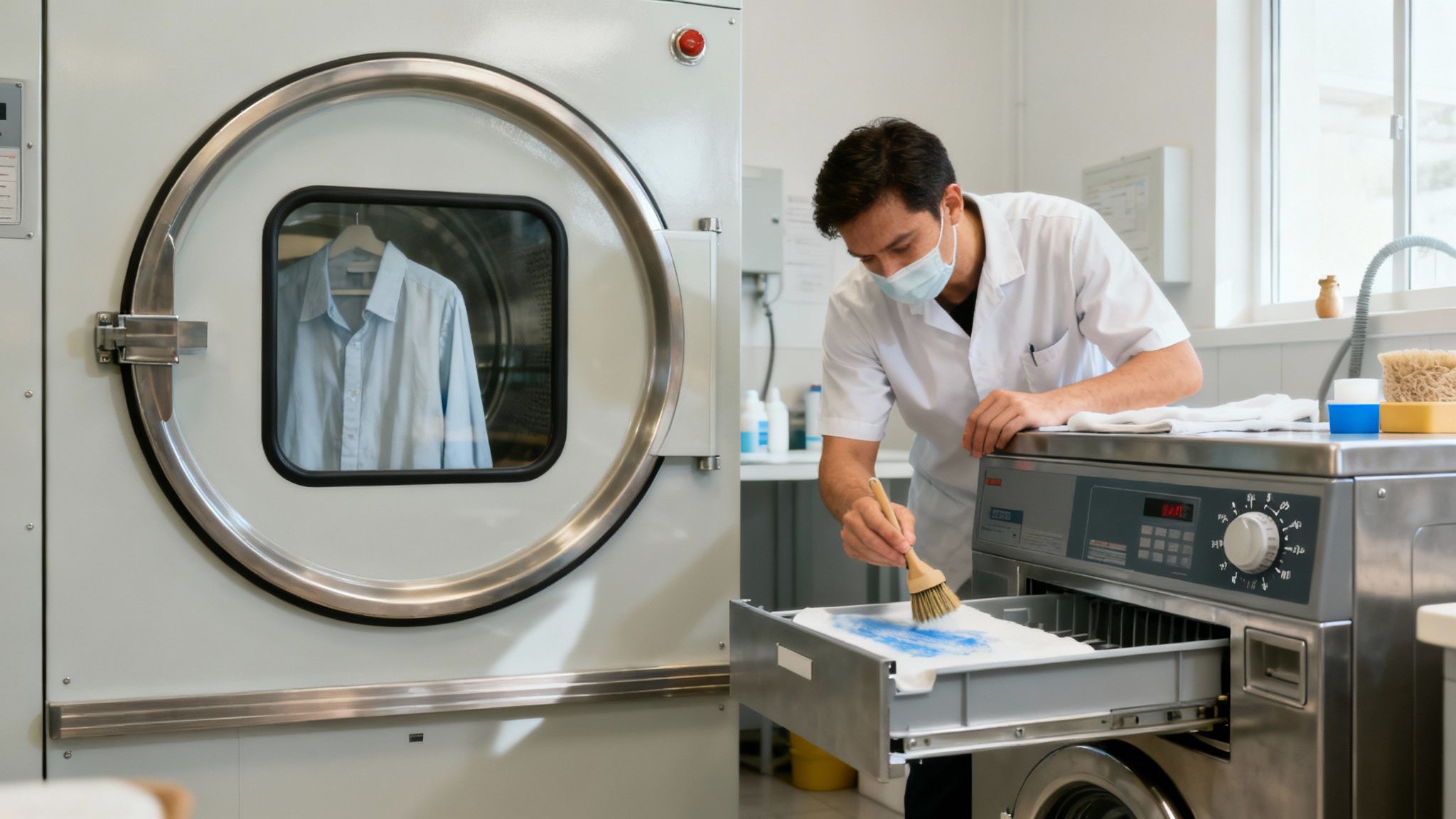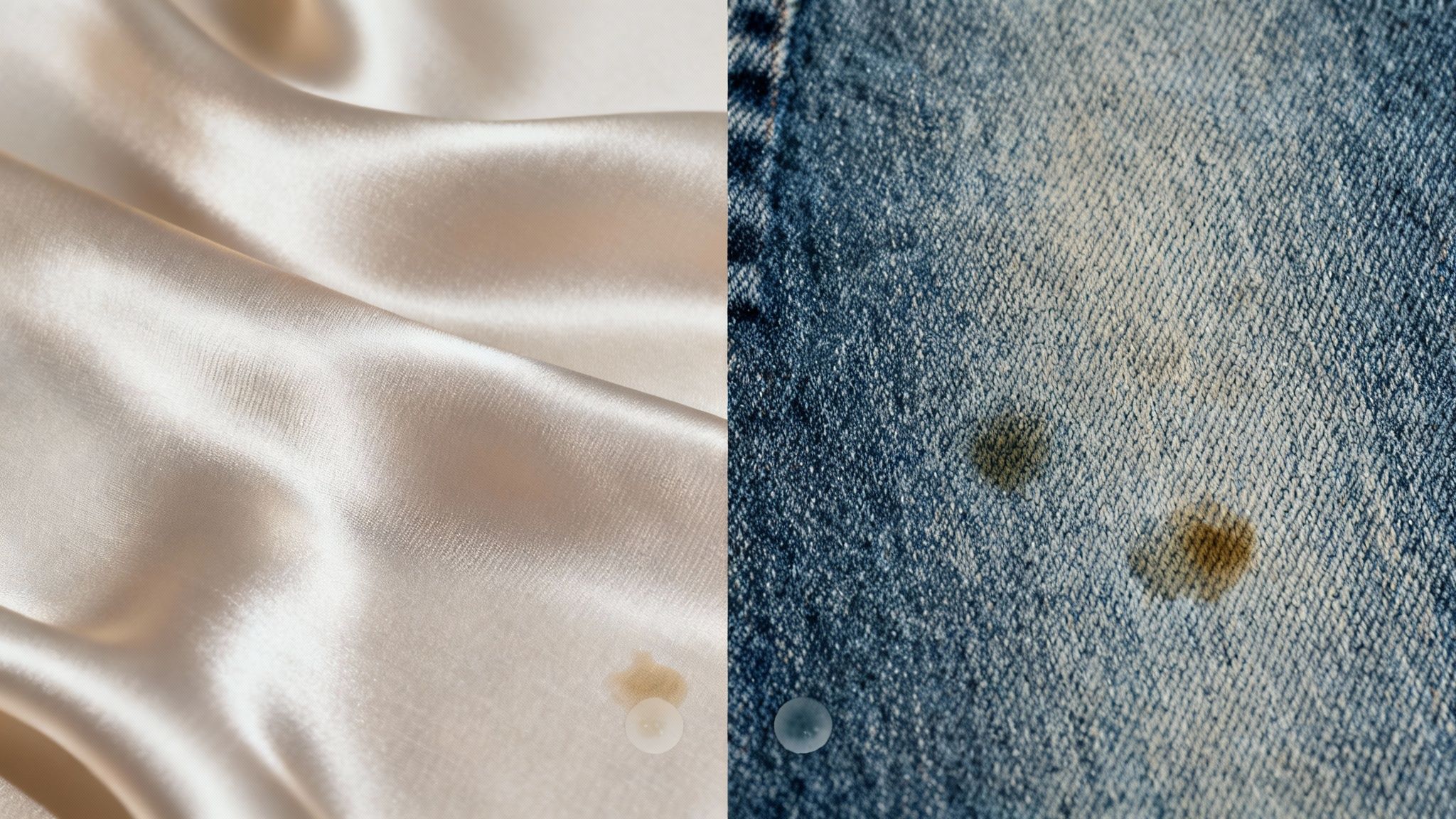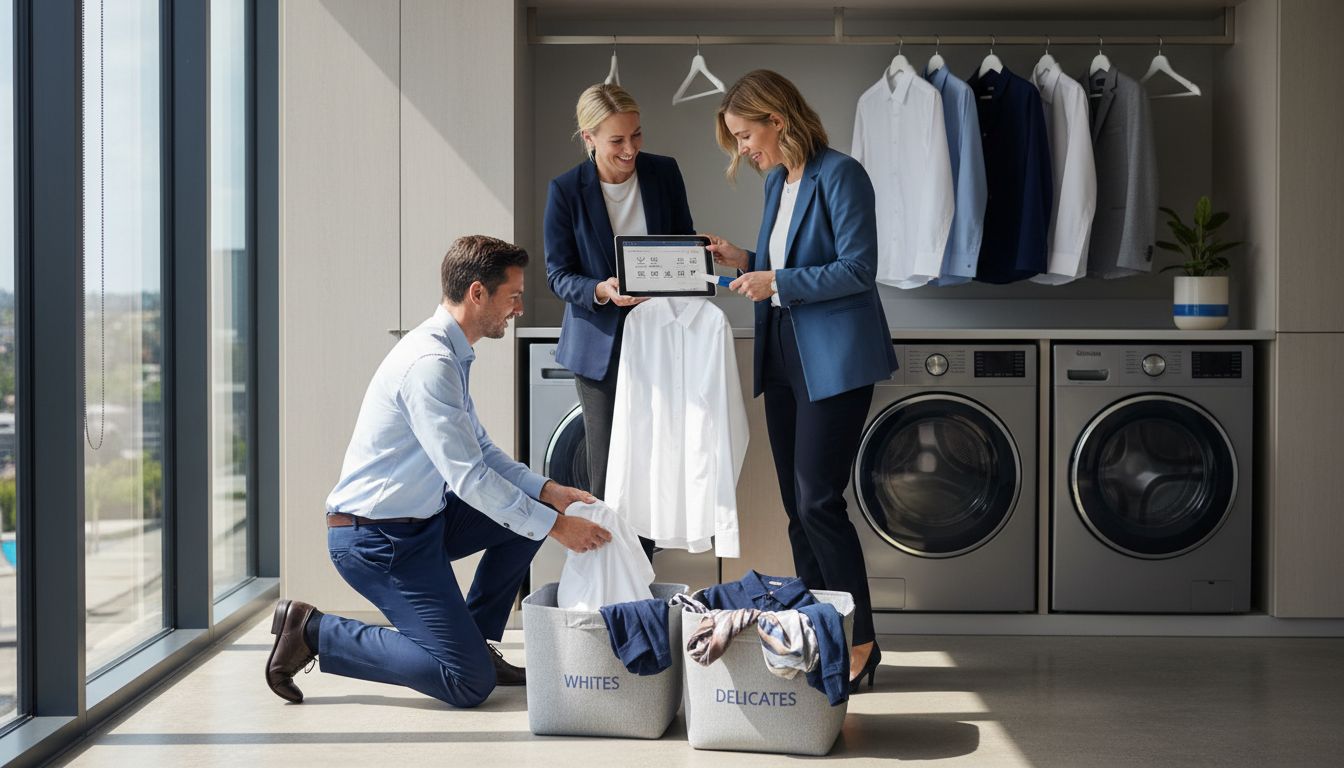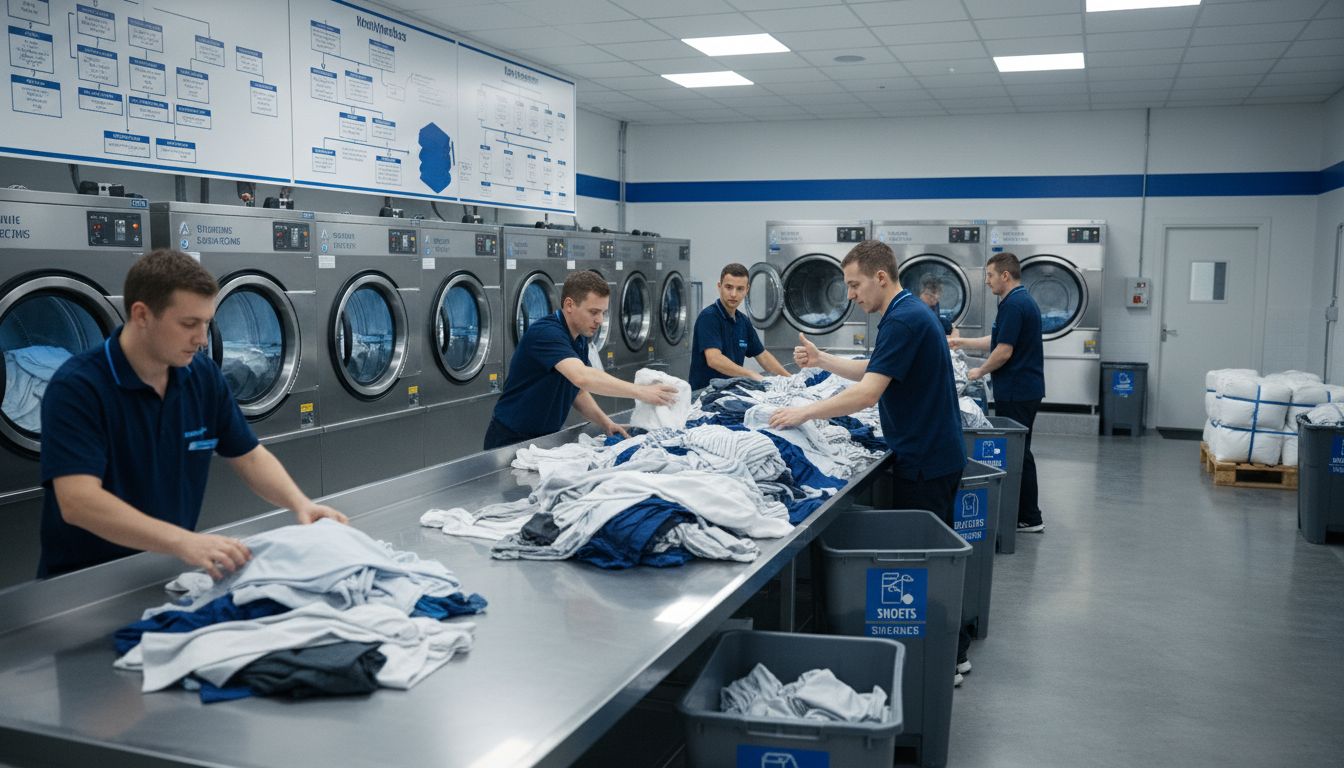Difference Between Dry Cleaning and Laundering: Quick Guide

When you get down to it, the real difference between dry cleaning and laundering boils down to one thing: the cleaning agent. In a nutshell, dry cleaning uses water-free chemical solvents to gently lift stains from delicate fabrics. Laundering, on the other hand, uses good old water and detergent for your more durable, everyday clothes.
Dry Cleaning vs Laundering: The Core Differences
Figuring out the main distinction between these two cleaning methods is key to preserving the life and look of your wardrobe. Each process is built for specific fabric types and stain challenges, and picking the right one can be the difference between a long-lasting garment and a shrunken, faded, or damaged one. This first look gives you a clear overview of what separates them before we dive into the nitty-gritty of each process and when to use them.

Quick Comparison: Dry Cleaning vs Laundering
To make the choice a bit simpler, let’s break down the essential differences side-by-side. Think of dry cleaning as the specialist you call for sensitive materials and laundering as the reliable workhorse for your daily wear.
While this table gives you a great high-level snapshot, the real magic is in the details. For instance, a beautiful silk blouse would be utterly ruined by the aggressive water and agitation of a washing machine, making dry cleaning the only viable option.
The core principle is pretty straightforward: water can damage delicate fibers by causing them to swell, shrink, or lose their shape. Dry cleaning completely bypasses this risk by using solvents that clean without ever saturating the fabric with water.
On the flip side, durable items like your favorite cotton t-shirts and trusty denim jeans respond perfectly to laundering, which is fantastic at removing sweat and everyday grime. Understanding this core distinction is what empowers you to make smarter decisions for every single item in your closet, ensuring each piece gets the proper care it needs to last for years.
A Look Inside The Cleaning Processes
To really get the difference between dry cleaning and laundering, you have to look past the names and see what’s actually happening to your clothes. These two methods are worlds apart—far more than just "wet vs. dry." They're distinct, multi-step processes engineered for completely different fabrics and stains, which is why one is perfect for a silk dress and the other is the go-to for your cotton sheets.

The Dry Cleaning Journey
Dry cleaning is a meticulous, almost surgical operation that avoids water entirely to protect delicate fibers. It's a common misconception that the process is literally "dry." While it doesn’t use water, it does use a liquid chemical solvent to do the heavy lifting.
- Tagging and Inspection: First, every garment gets tagged with a unique ID so it always finds its way back to you. Our experts then give it a thorough once-over, looking for specific stains, weak spots in the fabric, or loose buttons.
- Pre-Treatment: This is where the magic starts. Known as "spotting," skilled technicians target individual stains with specialized cleaning agents before the main cycle. This targeted approach is absolutely critical for knocking out stubborn, oil-based stains like grease or makeup.
- The Cleaning Cycle: Garments are placed in a sophisticated machine that looks a bit like a front-loading washer. They gently tumble in a precisely controlled solvent bath that lifts dirt and oils right out of the fabric. At Columbia Pike Laundry, we use an eco-friendly GreenEarth solvent, which is much gentler on your clothes and the planet.
- Finishing: Once the solvent is drained and reclaimed, the clothes are professionally steamed and pressed. This final step is what restores the garment's original shape, drape, and crisp, like-new appearance.
The real artistry in dry cleaning isn’t just the machine—it’s the combination of an expert’s eye for stains during pre-treatment and the gentle, water-free solvent action during the main cycle.
The Professional Laundering Method
Professional laundering is what your home wash routine wants to be when it grows up. It uses water, sure, but it pairs it with commercial-grade equipment, superior detergents, and precise temperature controls for a much deeper, more hygienic clean than any residential machine can deliver.
This process is built for durability and deep cleaning, making it the perfect choice for everyday workhorses like cotton shirts, denim, and bed linens. For a closer look at the machinery and solvents, you can learn more about how dry cleaning works in our comprehensive guide.
Key Stages of Laundering
- Sorting: Just like at home, but done with an expert’s precision. Whites, colors, and delicates are carefully separated to prevent any color bleeding or damage.
- Washing: Our commercial machines use specific water temperatures and advanced, professional-grade detergents designed to obliterate heavy soil and bacteria effectively.
- Drying and Finishing: Garments are tumbled dry at carefully controlled temperatures to minimize any chance of shrinking. They're then promptly removed, professionally folded, and packaged so they arrive at your door neat and ready to wear.
Understanding these two distinct workflows—one a gentle, solvent-based restoration and the other a powerful, water-based deep clean—is the key. It’s why that "Dry Clean Only" tag is a hard rule, not just a friendly suggestion, for keeping your most valued garments in perfect condition.
Comparing The Impact On Your Garments
Choosing between dry cleaning and laundering isn't just about following a care tag; it's a strategic decision that directly affects the health, appearance, and lifespan of your clothes. The core difference between the two—water versus solvent—creates wildly different results for everything from fabric texture and color vibrancy to stain removal. Getting this right is how you protect your wardrobe investment.

It’s no surprise that more people are seeking professional garment care. In 2025, the global dry cleaning and laundry services market hit a value of roughly USD 83.2 billion. Experts predict it will climb to around USD 149.1 billion by 2035, a trend fueled by our collective desire for convenience and results we just can't get at home. If you're curious about the details, you can dig into the full market analysis from Future Market Insights.
Stain Removal: A Tale Of Two Spills
The effectiveness of each method really comes down to the nature of the stain. It’s like using the right tool for the job—one is built for oil, the other for water.
- Dry Cleaning Excels with Oil-Based Stains: The chemical solvents used in dry cleaning are masters at dissolving grease, oils, and other synthetic stuff. This makes it the undisputed champ for tackling stains from salad dressing, makeup, or ink. Where water just spreads these messes, a solvent breaks them down on a molecular level.
- Laundering Dominates Water-Based Stains: For everyday spills like sweat, dirt, coffee, or juice, laundering is your best bet. Water and detergent team up to lift and wash away these common water-soluble stains from durable fabrics like cotton and polyester.
Fabric Integrity And Longevity
Beyond just getting things clean, the biggest difference between these two methods is how they treat the fabric itself. One preserves delicate fibers and structure, while the other gives resilient materials a deep, hygienic clean.
Dry cleaning's gentle tumbling and lack of water is a lifesaver for natural fibers like wool and silk. It helps garments keep their original shape, texture, and tailored fit without the risk of shrinking, stretching, or felting that water can cause.
Laundering, on the other hand, can be pretty tough on those same materials with its vigorous agitation and heat. But for robust fabrics like denim or cotton sheets, that same process is perfect for a thorough cleaning that removes bacteria and allergens.
Color Retention And Texture
How a garment looks and feels after cleaning is just as important as how clean it is. Here again, the two methods have totally different effects.
Dry cleaning is exceptionally kind to dyes, helping to prevent fading and color bleeding. It’s the reason your vibrant silk scarves and dark wool suits keep their rich hues for so much longer. The process also preserves the original texture, keeping fabrics soft and preventing the pilling that often comes with machine washing.
Laundering can sometimes cause colors to fade over time, especially with darker or brightly colored items. The constant friction and hot water can cause dyes to leach out. While it’s great for softening up cottons, the process can leave other fabrics feeling a bit rough or cause them to lose their intended drape. Of course, proper sorting and temperature control in professional laundering helps minimize these issues a great deal.
When To Choose Each Cleaning Method
Deciding between dry cleaning and laundering often boils down to a quick check of the care label. But what happens when that tag is missing, or the instructions just aren't clear?
Knowing the why behind each choice is what really helps you make the right call every time, protecting your clothes from accidental damage. The fundamental difference between the two methods is what dictates which fabrics and situations are a match for each. Your decision really comes down to the fabric type, the garment's construction, and the kind of stain you're trying to tackle. It's not as simple as "delicate" versus "durable"—it’s about preserving the specific qualities that make each piece unique.
When to Opt for Dry Cleaning
Dry cleaning is the go-to for anything that reacts poorly to water. Its solvent-based process gently cleans without causing shrinking, stretching, or color loss, making it non-negotiable for certain items.
Go with dry cleaning for:
- Structured Garments: Think tailored suits, blazers, and formal coats. They rely on internal structures like shoulder pads and linings to keep their shape. Water can completely warp these components, so dry cleaning is a must to maintain that crisp, tailored fit.
- Delicate Natural Fibers: Materials like silk, wool, cashmere, and velvet almost always need to be dry cleaned. Water can cause these fibers to felt, shrink, or lose their natural softness and shine.
- Items with Embellishments: Anything adorned with beads, sequins, or intricate embroidery is just too fragile for a washing machine. The gentle process of dry cleaning protects these details from getting snagged or ruined.
- Stubborn Oil-Based Stains: If you've spilled salad dressing, makeup, or grease on something, dry cleaning gives you the best shot at getting it out. The chemical solvents are specifically designed to dissolve oils that water would only spread around.
Think of dry cleaning as a specialized preservation service. You aren't just cleaning the garment; you're protecting its unique construction, texture, and color from the potential harm of a water-based wash.
When Laundering Is the Right Choice
Professional laundering is the perfect method for the workhorses in your wardrobe—those durable, everyday items that can handle a thorough, water-based clean. This process is incredibly effective at removing sweat, dirt, and other common water-soluble messes. For a deeper dive, check out our guide on the role of professional laundry services.
Choose laundering for:
- Durable Cottons and Linens: T-shirts, jeans, bedding, and towels are made for laundering. The process gets rid of dirt and bacteria, leaving them genuinely fresh and hygienic.
- Most Synthetic Fabrics: Materials like polyester, nylon, and acrylic are generally machine-washable and hold up well to laundering. They aren't as prone to shrinking or damage from water and detergent.
- Everyday Wear and Tear: For the clothes that see regular use and are exposed to sweat and grime, a professional wash cycle provides the deep clean they need to stay in top condition.
By understanding these specific use cases, you can confidently pick the right cleaning method and extend the life of your entire wardrobe.
4. Analyzing Cost And Environmental Factors
So, we've talked about fabrics and stains. Now let's get down to the brass tacks: what's this all going to cost, how long will it take, and what’s the impact on the planet? These are the practical questions that often drive the final decision between dry cleaning and laundering. Getting a clear picture here helps you line up your choice with your budget, your schedule, and what matters to you.

Breaking Down The Costs And Turnaround Time
There’s no getting around it: dry cleaning typically has a higher price tag per item than traditional laundering. And for good reason. You're paying for the specialized solvents, the high-tech machinery, and most importantly, the hands-on expertise. It’s a meticulous, multi-step process, from an expert pre-treating a tough stain to the final hand-pressing that gives a suit its crisp finish. Laundering, on the other hand, is usually priced by the pound, which makes it the go-to, cost-effective choice for all your everyday clothes and linens.
The numbers back this up. In 2024, standard laundry services made up a huge chunk of the market—about 61.88%—by processing staggering volumes. We're talking about industrial laundries that can churn through over 60,000 pounds of textiles in a single week. Dry cleaners handle much smaller, more delicate loads, but the demand for that specialized care is growing fast.
So, how long will you be without your favorite blazer or your weekly load of tees?
- Dry Cleaning: Plan for about 3 days. This isn't just sitting around; that time is crucial for the detailed inspection, spotting, cleaning, and professional finishing your structured or delicate garments need to look their best.
- Laundering: We can get your regular laundry back to you in 48 hours. Need it sooner? Here at Columbia Pike Laundry, we've got you covered with an Express option that guarantees a turnaround in under 24 hours.
The Environmental Equation
The conversation around green cleaning has thankfully come a long way. Laundering, of course, uses a good bit of water and the energy to heat it, but modern high-efficiency machines and better detergents have made a real dent in its footprint.
Dry cleaning, which once had a bad rap for using harsh chemicals like perchloroethylene (perc), has also seen a major shift. The industry is moving toward much greener, safer alternatives.
At Columbia Pike Laundry, we made a conscious choice to use GreenEarth, a non-toxic, biodegradable silicone solvent. It's incredibly gentle on fabrics but tough on dirt, giving you a powerful clean without the environmental baggage of old-school chemicals.
When you're thinking about the environmental side of dry cleaning, it’s also important to remember that professional cleaners are held to strict standards for safe chemical waste disposal. By choosing a cleaner that invests in modern, eco-friendly solvents, you’re making a much more sustainable choice.
Ultimately, being eco-conscious is about more than just one method. It's about washing full loads, using cold water whenever you can, and taking great care of your clothes so they last longer. For a deeper dive, check out our guide on how to make your laundry routine more sustainable. When you understand the nuances of cost, time, and sustainability, you can make a truly informed choice that works for you.
Your Top Garment Care Questions Answered
Even when you know the difference between dry cleaning and laundering, some situations can leave you guessing. Let’s wrap up by tackling some of the most common questions we hear from customers, giving you the kind of real-world advice you need to handle any garment care challenge.
Can I Just Launder a "Dry Clean Only" Garment at Home?
I get this question all the time, and the short answer is: please don’t. Think of that "Dry Clean Only" tag as a direct warning from the manufacturer. They’re telling you that something about that garment—the fabric, the dyes, or even the hidden structural bits like linings and shoulder pads—will likely be ruined by water, heat, or the tumbling of a washing machine.
For example, water is the enemy of fabrics like wool, causing it to felt up and shrink beyond recognition. It can also make delicate rayon lose its shape for good. Trusting the care label really is the simplest way to protect your clothes and make sure they last.
Which is Better for Getting Rid of Odors Like Smoke?
Both methods work wonders on odors, but they specialize in different kinds of smells. It really comes down to the source of the odor and the type of fabric.
- Dry cleaning is the undisputed champ for oil-based scents. The solvents are designed to dissolve the oily particles that trap stubborn smells like smoke or heavy perfume, making it the only real choice for delicate or structured garments.
- Professional laundering is fantastic at knocking out sweat and other water-based odors, especially in durable fabrics. The combination of high-performance detergents and carefully controlled hot water cycles literally flushes those smells right out.
The fabric is the final judge. A smoke-infused wool coat is a job for the dry cleaner, but a musty cotton gym shirt needs a good, thorough laundering.
How Do Professionals Know Which Method to Use?
It’s a mix of science, experience, and a keen eye. A true professional goes way beyond just glancing at the care tag.
First, the care label gives us our starting orders. From there, it's all about a hands-on inspection: feeling the fabric, checking the construction, and looking for any delicate embellishments. The final step is identifying any specific stains to determine the best pre-treatment. This complete analysis ensures we pick the method that will get the garment spotless while keeping its shape, color, and feel perfectly intact.
Is Eco-Friendly Dry Cleaning as Good as the Traditional Kind?
Absolutely, and in many ways, it's even better. Today’s eco-friendly solvents aren't just a "greener" option; they’ve been engineered to deliver a premium clean without the harshness of old-school chemicals.
Take a solvent like GreenEarth, for example. It’s incredibly effective at lifting oil-based stains, but because it’s chemically inert, it’s also remarkably gentle on delicate fibers. This means colors stay vibrant and fabrics remain soft, delivering a superior result that’s also much kinder to the planet.
Ready to give your clothes the expert care they deserve without adding another chore to your list? Columbia Pike Laundry offers convenient pickup and delivery for both professional dry cleaning and wash-and-fold laundry. Schedule your first pickup today and get your time back.
Popular Blog Articles

Meet the Author
Daniel Logan didn’t start CPL because he loved laundry. He started it because his family was drowning in time debt, and laundry was one of the biggest weights.
Mornings were chaos with two kids under 5. Evenings felt like catch-up. And weekends? Gone to sorting socks and folding piles.
He knew his story wasn’t unique. So he built a business that gave families like his just a little bit of breathing room one load at a time.
With no laundry experience but deep tech skills, Daniel rolled up his sleeves, doing every job himself while building systems that turned it into a modern laundry service that saves customers time, simplifies their lives, and delivers reliability they can count on.
That’s where CPL began. Not from a playbook, but from pain. From one dad trying to buy back time: for himself, and for every household like his.






